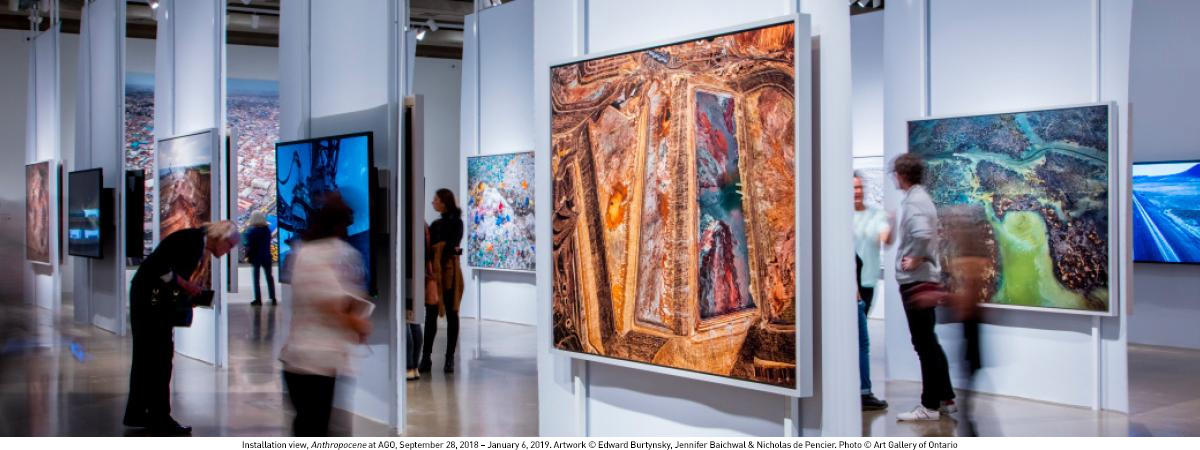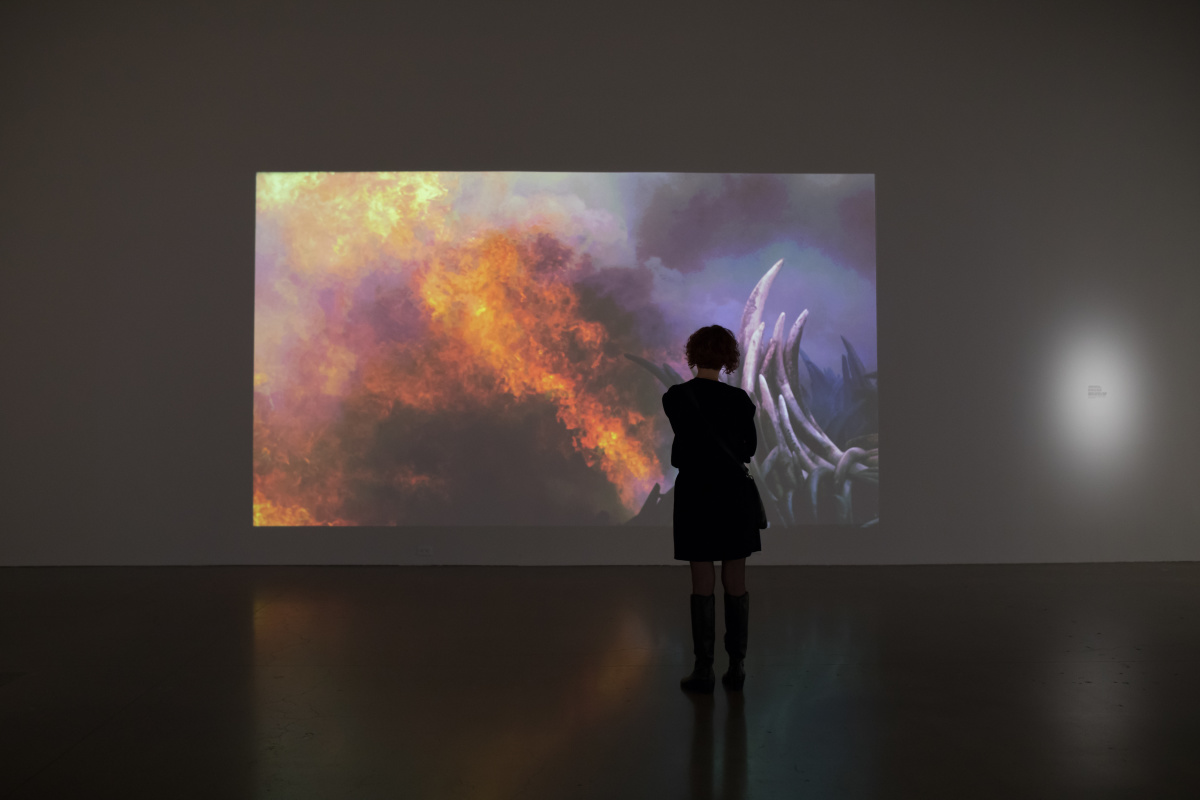Panasonic technology brings multimedia to life for Anthropocene at the AGO

When multiple award-winning filmmakers Jennifer Baichwal and Nicholas de Pencier and renowned photographer Edward Burtynsky announced a visionary new multi-media visual exhibition utilizing photography, film, and augmented reality, the AGO was up against complex technological challenges to make the artists’ vision into a reality. The exhibition required not only a huge physical scale but also, high-quality display technology that would live up to the detailed visual works being displayed. Simultaneously, the technology itself needed to blend completely into the overall experience, work flawlessly six days a week and support the exhibition’s fluid environment by producing vivid images from almost any viewing angle.
Challenge
The Art Gallery of Ontario (AGO) faced a unique set of technology challenges in order to debut a groundbreaking exhibition experience. To launch Anthropocene, an exhibition that blended large-scale photographs, murals, film installations and augmented reality installations, the AGO needed to integrate this different media to create an impactful exhibition experience and employ a scale and scope of display and projector technology where image quality, clarity and colour were second to none.
Solution
With an opportunity to collaborate as a technology partner to a visionary team of artists, Panasonic worked closely with the AGO and creators to choose the best visual display solution, making it possible to bring the vision of the show to life. This solution included seven TH-84EF1U 84” commercial displays, two PTRZ770 projectors, and a 75” interactive display.
Result
The partnership between the AGO and Panasonic set a new bar for how technology can support artistic exhibition design. Its implementation showed a brand new, strategic and thoughtful way to help visual artists tell stories that have the power to shape new futures and inspire participants to change the world.
The AGO partners with Panasonic to create immersive, cutting edge visuals in Anthropocene exhibition
When one of the most distinguished art museums in North America is preparing to host an exhibition by multiple award winning filmmakers Jennifer Baichwal and Nicholas de Pencier, and one of the world’s most respected photographers Edward Burtynsky, anticipations run high. Anthropocene combines art, film, augmented reality and scientific research to investigate human influence on both the current state and future of our planet.
Challenges
The ultimate success of the exhibition relied on the impact of its message. The quality and precision of the visuals — photography and video were crucial. To achieve the full potential and emotional resonance of Anthropocene, the AGO team needed technology that could vividly depict the scope and beauty of the visuals while at the same time running seamlessly.
To make this happen, the AGO’s curatorial team faced a multitude of both artistic and technical challenges. “Our first concern - and challenge - is always representing the art in a truthful manner, getting it as close to what the artist intended as possible. At the same time the technology needs to be as invisible and noninvasive as possible,” said Patric Colosimo, Senior Media Technician, Logistics & Art Services.
Solutions
When it came time to design the best technological approach to mounting the show, Panasonic was ready to not just provide equipment but collaborate closely with the AGO’ technical team and artists. The Panasonic team brought the curators and Anthropocene filmmaker and cinematographer Nicholas de Pencier to their offices with a wide range of commercial displays ready to be tested.
Panasonic displays, both in screen size and bezel, are unmatched and allowed us to find an exact fit.
With a desire to mimic the wide range of differently sized photographs in the exhibition, Panasonic’s broad range of commercial display sizes and bezel widths gave the AGO team the customizability and choice needed to turn their vision into reality. The scope of the solution was grand and included seven TH-84EF1U 84” commercial displays, two PT-RZ770 projectors with 7000 lumens and an ultra-short throw lens, and the TH75BQE1W 75” interactive display.
One of the unique challenges to a museum environment is the need for impeccable resolution at a variety of viewing angles. As people move throughout the space, it’s possible for them to discover the works from various viewpoints. The fluidity of the space was key to the flow of the story, and the 90-degree viewing capability on the Panasonic displays enabled a high resolution, undistorted viewing no matter the angle.
Unsurprisingly, the reproduction and quality of colours was also a key concern. The projectors and displays needed to be able to deliver the exact tone, hue and saturation in the videos to complement the photographs they would be placed next to. Even small deviations would be extremely noticeable and ruin the harmony and interplay of the video and photography that was a key facet of the exhibit. The PT-RZ770 laser projectors are specifically designed to produce brilliant picture quality and colour in a range of (even the most unique) applications.
Results
“We found not only that the Panasonic displays reproduce the films colour palette, but that we could create customized profiles and adjust the levels on a monitor to monitor basis if needed,” said Patric, “Panasonic displays, both in screen size and bezel, are unmatched and allowed us to find an exact fit.”
Jennifer Baichwal & Nicholas de Pencier, Elephant Tusk Burn, Nairobi National Park, Kenya, 2018. Installation view, Anthropocene at AGO, September 28, 2018 – January 6, 2019. Artwork © Jennifer Baichwal & Nicholas de Pencier, Photo © Art Gallery of Ontario
Panasonic’s technology blended seamlessly into the overall exhibition design of the exhibition and was also incredibly reliable - functioning flawlessly despite the rigors of operating extremely long hours during the high-demand exhibit. Another challenge of the environment, the equipment needed to operate with minimal upkeep for up to 18 hours a day, six days a week.
The solution was collaborative, innovative, and ultimately a remarkable success. “We were so very grateful to the team at Panasonic for their superlative technological expertise and exquisite line of media display options,” said artist, Nicholas de Pencier. “The process was a true collaboration as we worked together to create the very best experience of the hard-won images, we had captured for the Anthropocene project.”
